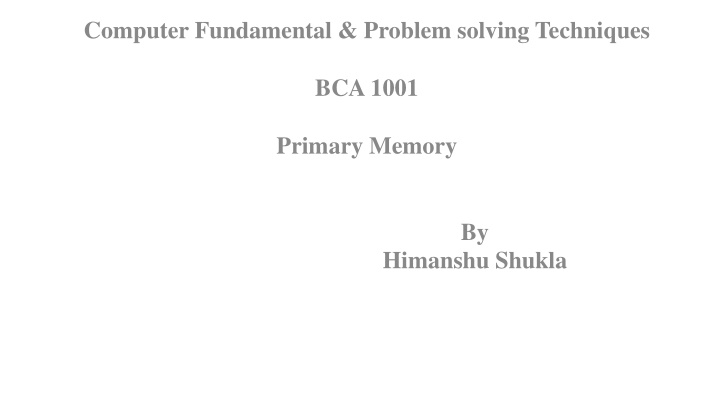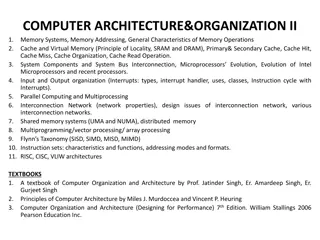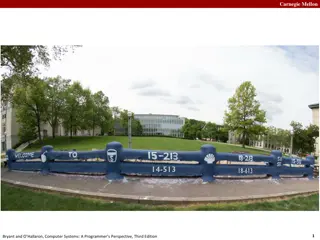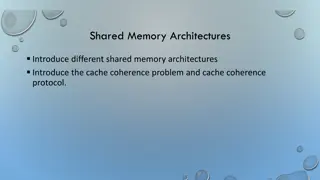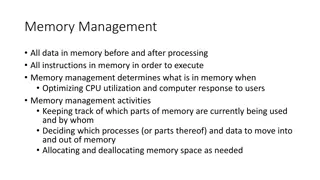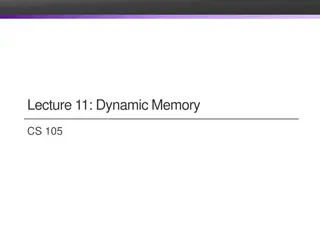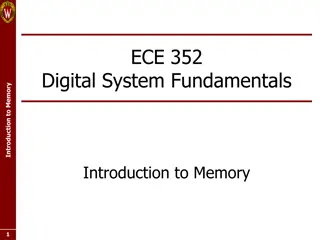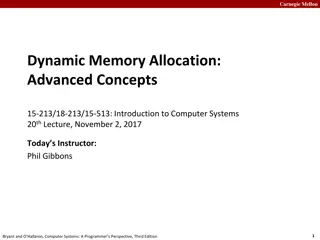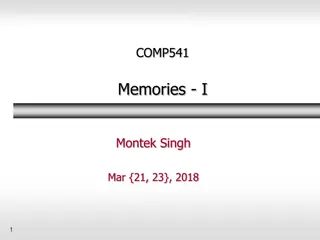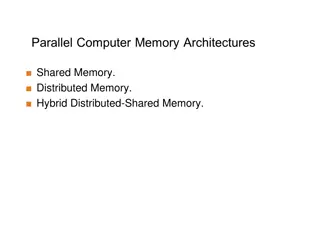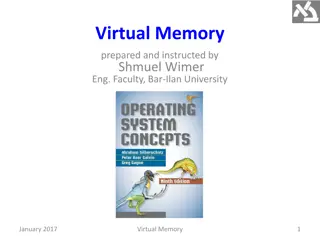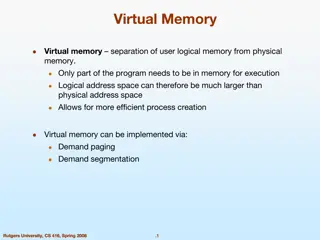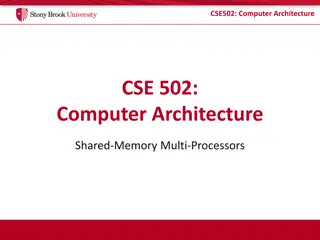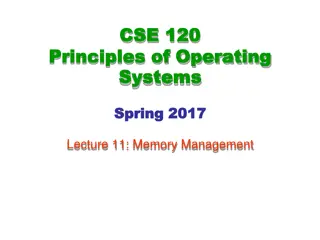Computer Primary Memory
Primary memory, also known as main memory, is a crucial component in a computer system that holds data and instructions currently in use. This memory type is volatile, meaning data is lost when the power is off. Primary memory consists of RAM and ROM, with characteristics that make it essential for a computer's functioning. RAM, a type of primary memory, allows faster data access but requires continuous power to retain information. Various types of RAM exist, including SRAM and DRAM, each with distinctive features and use cases.
Download Presentation

Please find below an Image/Link to download the presentation.
The content on the website is provided AS IS for your information and personal use only. It may not be sold, licensed, or shared on other websites without obtaining consent from the author.If you encounter any issues during the download, it is possible that the publisher has removed the file from their server.
You are allowed to download the files provided on this website for personal or commercial use, subject to the condition that they are used lawfully. All files are the property of their respective owners.
The content on the website is provided AS IS for your information and personal use only. It may not be sold, licensed, or shared on other websites without obtaining consent from the author.
E N D
Presentation Transcript
Computer Fundamental & Problem solving Techniques BCA 1001 Primary Memory By Himanshu Shukla
Primary Memory (Main Memory) Primary memory holds only those data and instructions on which the computer is currently working. It has a limited capacity and data is lost when power is switched off. It is generally made up of semiconductor devices. These memories are not as fast as registers. It is divided into two subcategories RAM and ROM.
Characteristics of Main Memory These are semiconductor memories. It is known as the main memory. Usually volatile memory. Data is lost in case power is switched off. It is the working memory of the computer. Faster than secondary memory. A computer cannot run without the primary memory.
RAM (Random Access Memory) Alternatively referred to as main memory, primary memory, or system memory, Random Access Memory. (Ram) is a hardware device that allows information to be stored and retrieved on a computer. The computer can access the data much faster. RAM is a volatile memory and requires power to keep the data accessible. If the computer is turned off, all data contained in RAM is lost.
Types of RAM Over the evolution of the computer, there have been different variations of RAM. Some of the more common examples are SRAM (Static Random Access Memory) DRAM (Dynamic Random Access Memory) SDRAM (Synchronous Dynamic Random Access Memory) DDR SDRAM (Double Data Rate Synchronous Random Access Memory) RDRAM (Rambus Dynamic Random Access Memory)
SRAM (Static Random Access Memory) S RAM retains stored information only as long as the power supply is on. Costlier are used and consumed more power. They have higher speed than D RAM`s. No need to be refreshed. Static RAM is fast and expensive. Static RAM is used to create the CPU`s speed sensitive cache.
DRAM (Dynamic Random Access Memory) DRAM was first invented and patented by Robert Dennard in 1968 and first released commercially by Intel in October 1970. It stores its information in a cell containing a capacitor and transistor. Need to be refreshed. DRAM is less expensive to produce than SRAM. DRAM requires less power than SRAM.
ROM (Read Only Memory) ROM is a permanent type of memory. Its contents are not erased when the power supply is switched off however, the user can not write into a ROM, and its contents are retained in additional manufacturing time. ROMs store permanent programs and other types of Data that are needed by the computer to execute user programs different types of ROMs.
Types of ROM There are five basic ROM types. Mask ROM PROM (Programmable Read Only Memory) EPROM (Erasable Programmable Read Only Memory) EEPROM (Electrically Erasable Programmable Read Only Memory) FLASH ROM
Mask ROM It is a static ROM. A type of read-only memory (ROM). A fixed program read-only memory in which the data content of each cell is determined during manufacture by the use of a mask.
PROM (Programmable Read Only) It was first developed in the 70s by Texas instruments. The data stored in it cannot be modified; therefore, it is also known as a one-time programmable device. It can be programmed only once and is not erasable. The user buys a blank PROM and enters the desired contents using a PROM program.
EPROM (Erasable Programmable ROM) EPROM chips can be rewritten many times. It is very cost-effective. It retains memory even without power. It is re-programmable as mentioned above. It is easy to erase EPROM completely by exposing it to ultraviolet light.
EEPROM (Electrically Erasable PROM) It can be erased and reprogrammed about ten thousand times. Both erasing and programming takes about 4 to 10 m.s (milliseconds). EEPROMs can be erased one byte at a time, rather than erasing the entire chip. Hence, the process of reprogramming is flexible but slow. The method of erasure is electrical and immediate.
FLASH ROM FLASH ROM is used for android devices. There are also some things called custom ROM. It will provide you with better functionality, user interface, features, and more. Many android users are going for custom ROMs, as they help them change the look and feel however they want.
